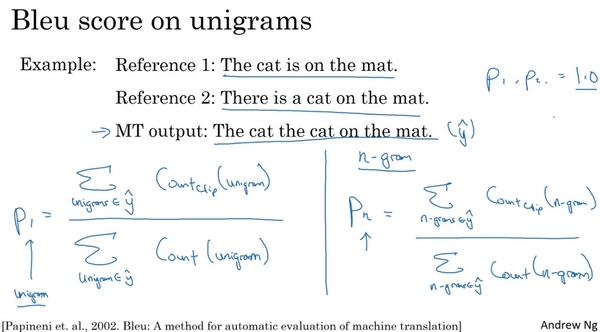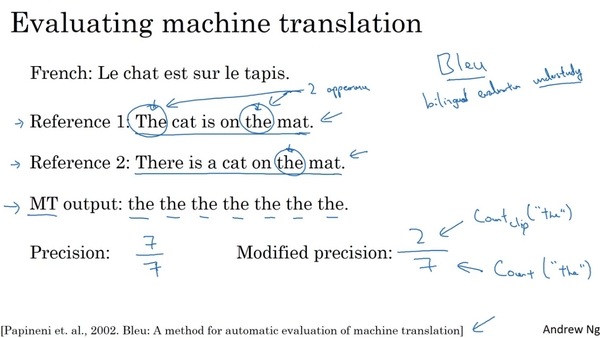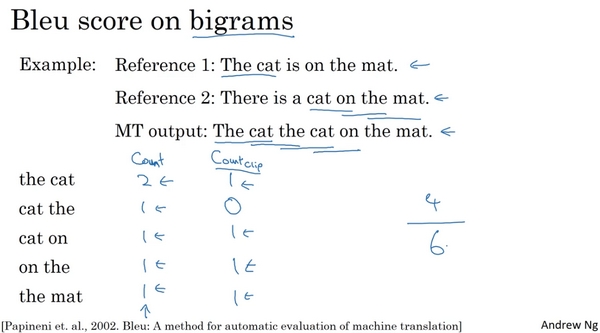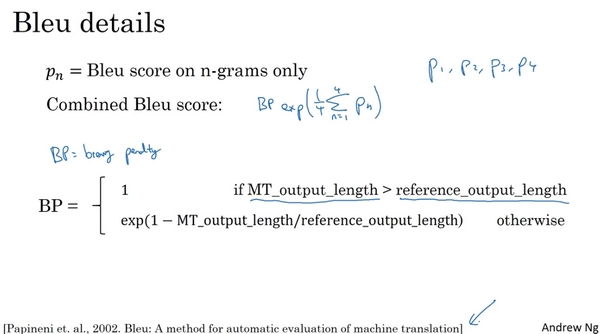3.6 Bleu 得分(选修)(Bleu Score (optional))
机器翻译(machine translation)的一大难题是一个法语句子可以有多种英文翻译而且都同样很好,常见的解决办法是通过一个BLEU得分(the BLEU score)的东西来解决,BLEU得分是一个有用的单一实数评估指标,用于评估生成文本的算法,判断输出的结果是否与人工写出的参考文本的含义相似
一般有多个人工翻译:
BLEU得分做的就是给定一个机器生成的翻译,它能够自动地计算一个分数来衡量机器翻译的好坏。只要机器生成的翻译与任何一个人工翻译的结果足够接近,那么它就会得到一个高的BLEU分数。BLEU代表bilingual evaluation understudy(双语评估替补)。且这些人工翻译的参考会包含在开发集或是测试集中
假设机器翻译 (MT)的输出是:the the the the the the the,是一个十分糟糕的翻译。衡量机器翻译输出质量的方法之一是观察输出结果的每一个词,看其是否出现在参考中,这被称做是机器翻译的精确度(a precision of the machine translation output)。这个情况下,机器翻译输出了七个单词并且这七个词中的每一个都出现在了参考1或是参考2,因此输出的精确度就是7/7,分母为机器翻译单词数目,分子为相应单词是否出现在参考翻译中。但是,这种方法很不科学,并不可取
改良后的精确度评估方法(the modified precision measure):把每一个单词的记分上限定为它在参考句子中出现的最多次数。在参考1中,单词the出现了两次,在参考2中,单词the只出现了一次。单词the的得分上限为2。输出句子的得分为2/7,分母是7个词中单词the总共出现的次数,分子是单词the出现的计数,在达到上限时截断计数
上述都只是关注单独的单词,在BLEU得分中,另外一种更科学的打分方法是bleu score on bigrams(二元词组),bigram的意思就是相邻的两个单词
定义截取计数(the clipped count),也就是Count_clip:给算法设置得分上限,上限值为二元词组出现在参考1或2中的最大次数
假定机器翻译输出了稍微好一点的翻译,对MT output进行分解,得到的bigrams及其出现在MT output中的次数count为:
相应的bigrams precision为4/6也就是2/3,为二元词组改良后的精确度
将改良后的一元词组精确度定义为,代表的是精确度。下标1的意思是一元词组,即考虑单独的词, 定义为元词组精确度,用n-gram替代掉一元词组。即机器翻译输出中的元词组的countclip之和除以元词组的出现次数之和

如果机器翻译输出与参考1或是参考2完全一致,那么所有的、等等的值,都会等于1.0
最终的BLEU得分:
将得到的,, ... 相加再取平均值
BLEU得分被定义为:
然后用BP(“简短惩罚”brevity penalty) 的惩罚因子(the BP penalty)来调整。它能够惩罚输出了太短翻译结果的翻译系统:
BLEU得分被用来评估许多生成文本的系统(systems that generate text),比如说机器翻译系统(machine translation systems),图像描述系统(image captioning systems)。不过它并没有用于语音识别(speech recognition)。因为在语音识别当中,通常只有一个答案
Last updated
Was this helpful?


